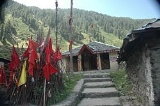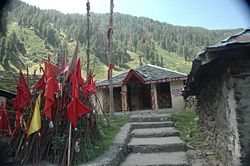
Bharmour
Encyclopedia
Bharmour, formally known as Brahmpura, was the ancient capital of Chamba district
, India
. Situated at an altitude of 7000 feet in the Budhil valley (32.26°N 76.32°E), forty miles to the south-east of Chamba
, Bharmour is known for its scenic beauty and for its ancient temples. Some of temples are believed to be existing from 10th century.
As the whole country around Bharmour is supposed to belong to lord Shiva
, it is popularly spoken of as Shiva Bhumi, abode of lord Shiva. Being the home of an interesting tribe of Gaddis, it is also called Gadderan.
through the outer hills. He defeated the petty Ranas
holding the territory there and founded the town Brahampura and made it the capital of a new state. This event is believed to have taken place in the middle of 6th century A.D..
According to one legend, the name Brahampura was in use at a still earlier period for the more ancient kingdom of Bharmour which existed in the territories of Garhwal
and Kumaon
, and that Maru gave the same name of Brahampura to the state that he founded with present Bharmour as his capital.
After Maru, several Rajas ruled in succession until Sahil Varman. It was Sahil Varman who conquered the lower Ravi valley and transferred the seat of government from Brahampura to the new capital he founded at Chamba. Bharmour was capital for probably four hundred years.
The original state was of very small extent and in all likelihood comprised at the most the present Bharmour sub-division i.e. the valley of the Ravi below Bara Bangahal, with its tributaries, the Budhil and the Tundah as far down as Chhatrari.
 According to a local legend, the place Brahampura was older than Maru's time and as per common belief this used to be the vatika (garden) of goddess Brahamani who used to reside where her shrine now stands on the ridge at a distance of 3-4 kilometers. Brahamani Devi was having a son who was very fond of his pet choker or (birds). One day the choker was killed by a peasant and the son was shocked to death by this loose . Grief-stricken, Brahmani Devi also sacrificed by burying herself alive. The spirits of these trio dead souls started haunting the people awfully who raised Brahmani Devi to the status of deity and built her a temple. The people believe that the place was called Brahmpura after Brahamani Devi.
According to a local legend, the place Brahampura was older than Maru's time and as per common belief this used to be the vatika (garden) of goddess Brahamani who used to reside where her shrine now stands on the ridge at a distance of 3-4 kilometers. Brahamani Devi was having a son who was very fond of his pet choker or (birds). One day the choker was killed by a peasant and the son was shocked to death by this loose . Grief-stricken, Brahmani Devi also sacrificed by burying herself alive. The spirits of these trio dead souls started haunting the people awfully who raised Brahmani Devi to the status of deity and built her a temple. The people believe that the place was called Brahmpura after Brahamani Devi.
The legend further says that God Shiva with 84 Sidhas while on his way to Manimahesh happened to visit Brahmpura, the Vatika of the Goddess Brahmani Devi and settle there for the night. When Brahmani Devi, the presiding deity of the place saw the smoke of fires lit by the Sidhas, she felt very angry at this trespass. She came down to the place and ordered Shiva and the Sidhas to get out of the place. Shiva importuned in all his humility for allowing them to spend a night there. Goddess Brahamani condescended to their wishes. The 84 Mahasiddhas transformed themselves in to 84 Lingas because they wished to settle there.
The Lord Shiva granted a boon to Brahamani Devi that all persons intending to go on pilgrimage to Manimahesh must have a dip in Brahmani pool. Failing this, their pilgrimage would not be acceptable to Lord Shiva.
In September 2007, the Government of Himachal Pradesh started chopper service to the temple located at an altitude of 14,000 ft.
Chamba district
Chamba is the northwestern district of Himachal Pradesh, in India, with its headquarters in Chamba town. The towns of Dalhousie and Khajjhiar are popular hill stations and vacation spots for the people from the plains of northern India....
, India
India
India , officially the Republic of India , is a country in South Asia. It is the seventh-largest country by geographical area, the second-most populous country with over 1.2 billion people, and the most populous democracy in the world...
. Situated at an altitude of 7000 feet in the Budhil valley (32.26°N 76.32°E), forty miles to the south-east of Chamba
Chamba, Himachal Pradesh
Chamba is an ancient town in the Chamba district in the state of Himachal Pradesh, in northern India. According to the 2001 Indian census, Chamba has a population of 20,312 people...
, Bharmour is known for its scenic beauty and for its ancient temples. Some of temples are believed to be existing from 10th century.
As the whole country around Bharmour is supposed to belong to lord Shiva
Shiva
Shiva is a major Hindu deity, and is the destroyer god or transformer among the Trimurti, the Hindu Trinity of the primary aspects of the divine. God Shiva is a yogi who has notice of everything that happens in the world and is the main aspect of life. Yet one with great power lives a life of a...
, it is popularly spoken of as Shiva Bhumi, abode of lord Shiva. Being the home of an interesting tribe of Gaddis, it is also called Gadderan.
History
Meru, the father of the first recorded prince Jaistambh in the Chamba Vanshavali was the first to settle Bharmour. He belonged to a ruling family of Ayodhya. Accompanied by his youngest son Jaistambh, Meru penetrated to the upper Ravi valleyRavi River
The Ravi is a trans-boundary river flowing through Northwestern India and eastern Pakistan. It is one of the six rivers of the Indus System in Punjab region ....
through the outer hills. He defeated the petty Ranas
Rana (title)
Rana is a Princely title of Royalty in Sanskrit. Rana is used by the Jats and Rajput of South Asia. The name is usually interpreted to mean "Prince".Compound titles Rana Sahib, Rana Bahadur, and Maharana.-Royal title in India:...
holding the territory there and founded the town Brahampura and made it the capital of a new state. This event is believed to have taken place in the middle of 6th century A.D..
According to one legend, the name Brahampura was in use at a still earlier period for the more ancient kingdom of Bharmour which existed in the territories of Garhwal
Garhwal Kingdom
Garhwal Kingdom was a princely state in north-western Uttarakhand, India, ruled by the Panwar dynasty. It was founded in 888 AD and existed until it was annexed by the Gorkhas in 1803...
and Kumaon
Kumaon Division
For Kumaoni/Kumauni People see Kumauni PeopleKumaon or Kumaun is one of the two regions and administrative divisions of Uttarakhand, a mountainous state of northern India, the other being Garhwal. It includes the districts of Almora, Bageshwar, Champawat, Nainital, Pithoragarh, and Udham Singh Nagar...
, and that Maru gave the same name of Brahampura to the state that he founded with present Bharmour as his capital.
After Maru, several Rajas ruled in succession until Sahil Varman. It was Sahil Varman who conquered the lower Ravi valley and transferred the seat of government from Brahampura to the new capital he founded at Chamba. Bharmour was capital for probably four hundred years.
The original state was of very small extent and in all likelihood comprised at the most the present Bharmour sub-division i.e. the valley of the Ravi below Bara Bangahal, with its tributaries, the Budhil and the Tundah as far down as Chhatrari.

The legend further says that God Shiva with 84 Sidhas while on his way to Manimahesh happened to visit Brahmpura, the Vatika of the Goddess Brahmani Devi and settle there for the night. When Brahmani Devi, the presiding deity of the place saw the smoke of fires lit by the Sidhas, she felt very angry at this trespass. She came down to the place and ordered Shiva and the Sidhas to get out of the place. Shiva importuned in all his humility for allowing them to spend a night there. Goddess Brahamani condescended to their wishes. The 84 Mahasiddhas transformed themselves in to 84 Lingas because they wished to settle there.
The Lord Shiva granted a boon to Brahamani Devi that all persons intending to go on pilgrimage to Manimahesh must have a dip in Brahmani pool. Failing this, their pilgrimage would not be acceptable to Lord Shiva.
In September 2007, the Government of Himachal Pradesh started chopper service to the temple located at an altitude of 14,000 ft.

